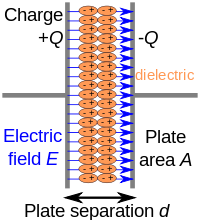
Photo from wikipedia
In this paper, screen-printed electrodes are asymmetrically fabricated on three different dielectrics (multi-layered polyimide, quartz, and alumina). Supplied with AC power, sustainable surface dielectric barrier discharge (SDBD) plasma is generated… Click to show full abstract
In this paper, screen-printed electrodes are asymmetrically fabricated on three different dielectrics (multi-layered polyimide, quartz, and alumina). Supplied with AC power, sustainable surface dielectric barrier discharge (SDBD) plasma is generated in atmospheric pressure. During plasma processing, different changes of material degradation and discharge images are observed. The corresponding electrical and optical characteristics are investigated by optical emission spectra (OES) and Lissajous figure analysis, respectively. It is found that both dielectric degradation and electrode erosion occur on the surface of the polyimide based SDBD device, while there is only electrode erosion for the quartz and alumina based devices, which results in different changes of electrical characteristics. OES calculated results show that with an increase of discharge aging time, electron temperature increases for the polyimide based SDBD device and decreases for quartz and alumina based SDBD devices, while all the gas temperatures of three dielectrics increase with the aging time. Furthermore, compared to vibrational temperature and gas temperature, the distribution of electron temperature is more suitable for evaluating the changes in discharge uniformity during plasma processing.In this paper, screen-printed electrodes are asymmetrically fabricated on three different dielectrics (multi-layered polyimide, quartz, and alumina). Supplied with AC power, sustainable surface dielectric barrier discharge (SDBD) plasma is generated in atmospheric pressure. During plasma processing, different changes of material degradation and discharge images are observed. The corresponding electrical and optical characteristics are investigated by optical emission spectra (OES) and Lissajous figure analysis, respectively. It is found that both dielectric degradation and electrode erosion occur on the surface of the polyimide based SDBD device, while there is only electrode erosion for the quartz and alumina based devices, which results in different changes of electrical characteristics. OES calculated results show that with an increase of discharge aging time, electron temperature increases for the polyimide based SDBD device and decreases for quartz and alumina based SDBD devices, while all the gas te...
Journal Title: Journal of Applied Physics
Year Published: 2018
Link to full text (if available)
Share on Social Media: Sign Up to like & get
recommendations!